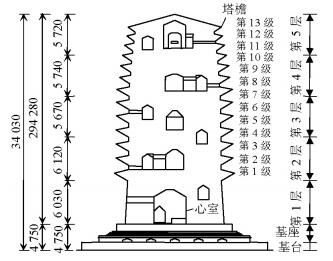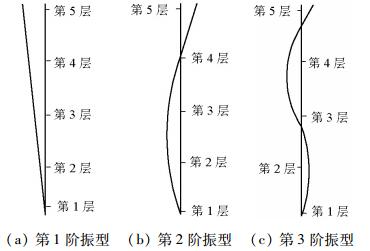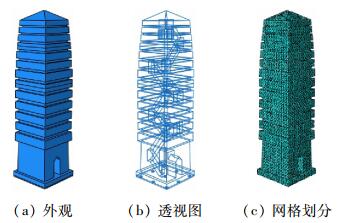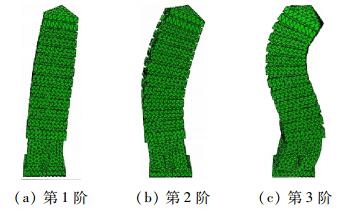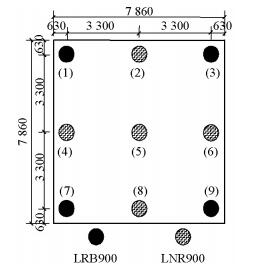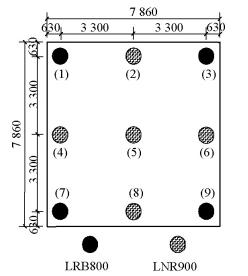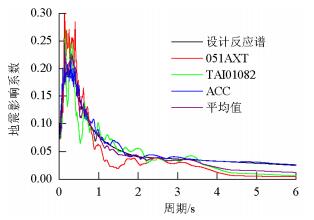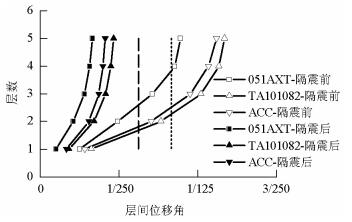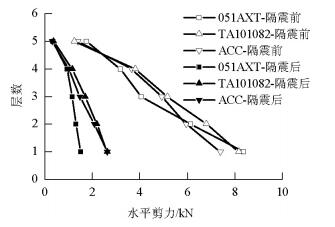Study on Isolated Reinforcement Scheme of Ancient Masonry Pagoda in Sichuan Province
-
摘要: 为了更好的保护砖石古塔,最大限度的保留古塔原有建筑和历史风貌,以彭州镇国寺白塔为实例,通过布置不同的隔震方案,分析不同方案下古塔的隔震性能,对比了罕遇地震作用下古塔隔震前后的顶点最大加速度、层间位移和剪力,并进行了隔震后古塔的抗风和抗倾覆验算.研究结果表明:古塔隔震方案宜采用选取尺寸较大的隔震支座,并将其沿隔震层外缘均匀布置;隔震后古塔在罕遇地震作用下的响应显著降低,其中顶点最大加速度下降了80%,层间剪力下降了70%,有效提高了古塔的抗震安全性.Abstract: In order to more effectively protect masonry pagodas and retain their original historical style and features, Pengzhou Zhenguo White Pagoda was examined as a representative case. The isolation performance of the pagoda was analysed using different isolation schemes as parameters. The vertex maximum acceleration, interlayer displacement, and shear force values under rarely severe earthquake before and after isolation were compared, and the wind resistant and anti-overturn status after isolation were calculated. The results showed that the seismic response could be reduced under a rare earthquake by selecting larger isolation bearings and an outer edge arrangement. The maximum acceleration of the vertex was decreased by approximately 80%, while the horizontal shear was decreased by approximately 70%, which effectively improved the seismic safety of the masonry pagoda.
-
Key words:
- masonry pagoda /
- base isolation /
- strengthening measure /
- time-history analysis
-
表 1 白塔的几何尺寸
Table 1. Physical dimensions of the White Pagoda
mm 层数 层高 边长 墙厚 心室长 心室宽 1 6 030 6 740 950 2 200 1 940 2 6 120 6 300 930 1 220 1 330 3 5 670 6 380 920 1 220 1 150 4 5 740 6 320 920 1 220 1 110 5 5 720 5 690 640 2 000 1 500 表 2 白塔砌体的力学参数
Table 2. Mechanical parameters of the White Pagoda
层数 密度/(kg·m-3) 泊松比 抗压强度/MPa 抗剪强度/MPa 弹性模量/MPa 1~4层 1 800 0.15 1.13 0.062 1 245.20 5层 1 800 0.15 0.94 0.051 592.20 表 3 白塔模型的局部简化
Table 3. Local simplified model of the White Pagoda
部位 简化前 简化后 蹬道 

塔檐 

表 4 白塔自振频率的计算值与实测值对比
Table 4. Comparison of measured and simulated the White Pagoda frequencies
阶数 南北向 东西向 实测值/Hz 计算值/Hz 误差/% 实测值/Hz 计算值/Hz 误差/% 第1阶 1.07 1.03 3.63 1.07 1.06 0.96 第2阶 4.59 5.05 9.97 4.59 4.97 8.25 第3阶 8.40 11.02 31.22 8.70 10.61 21.98 表 5 隔震支座参数
Table 5. Parameters of isolation bearings
型号 有效直径/mm 总厚度/mm 竖向刚度/(kN·mm-1) 水平屈服力/kN 100%水平剪切应变时刚度/(kN·mm-1) 100%剪切应变水平等效刚度/(kN·mm-1) 屈服前 屈服后 LRB800 800 175 3 753 160.30 14.73 1.13 2.05 LRB900 900 198 4 013 202.90 16.48 1.27 2.29 LNR800 800 175 3 358 — — — 1.11 LNR900 900 198 3 559 — — — 1.24 表 6 隔震支座在重力荷载代表值作用下压应力
Table 6. Press stress of isolation bearings under gravity load
MPa 支座编号 方案1 方案2 方案3 (1) 1.93 2.52 3.16 (2) 3.55 4.30 4.32 (3) 3.54 2.53 3.18 (4) 1.95 4.51 4.56 (5) 3.66 5.53 5.54 (6) 3.59 4.44 4.46 (7) 5.39 2.80 3.52 (8) 3.81 3.44 3.45 (9) 3.74 2.91 3.66 (10) 2.21 — — (11) 3.04 — — (12) 3.03 — — (13) 2.34 — — 表 7 隔震支座的最大拉应力
Table 7. Stress of isolation bearings
MPa 支座编号 方案1 方案2 方案3 (1) 0.12 -0.12 -0.04 (2) -2.21 -2.81 -2.94 (3) -0.25 0.94 0.95 (4) 0.98 -0.61 -0.47 (5) -0.37 -3.72 -3.84 (6) 0.99 1.04 0.87 (7) -3.45 -0.36 -0.38 (8) -0.51 -2.36 -2.44 (9) 0.95 0.80 0.78 (10) -0.14 — — (11) -1.78 — — (12) -0.50 — — (13) 0.86 — — 表 8 隔震前后的白塔前3阶周期对比
Table 8. Comparison of the White Pagoda periods before and after isolation
s 阶数 隔震前 隔震后 第1阶 0.97 1.50 第2阶 0.94 1.47 第3阶 0.24 0.75 表 9 顶点最大水平加速度
Table 9. Maximum horizontal acceleration of top layer
m/s2 地震波 051AXT TAI01082 ACC 隔震前 18.60 12.14 14.74 隔震后 3.27 2.75 2.79 表 10 风荷载作用下各层剪力
Table 10. Shear force of each layer under wind load
层数 第5层 第4层 第3层 第2层 第1层 剪力值/kN 179.49 136.77 87.83 47.50 18.15 表 11 隔震支座所承受最大拉应力
Table 11. Maximum tensile stress of isolation bearings
MPa 支座编号 支座型号 051AXT TAI01082 ACC (1) LRB800 -0.35 1.10 -0.04 (2) LNR900 -3.77 -3.22 -2.94 (3) LRB800 -0.50 -2.76 0.95 (4) LNR900 -0.87 1.00 -0.47 (5) LNR900 -4.81 -4.14 -3.84 (6) LNR900 -0.96 -3.86 0.87 (7) LRB800 -0.67 0.78 -0.38 (8) LNR900 -2.99 -2.60 -2.44 (9) LRB800 -0.80 -3.17 0.78 注:表中正值表示受拉, 负值表示受压. -
李德虎, 魏琏.砖石古塔的历史震害与抗震机制[J].建筑科学, 1990, 1(1):13-18. http://www.wanfangdata.com.cn/details/detail.do?_type=perio&id=QK000001919851LI Dehu, WEI Lian. The history of earthquake damage and seismic mechanism in masonry pagoda[J]. Building Science, 1990, 1(1):13-18. http://www.wanfangdata.com.cn/details/detail.do?_type=perio&id=QK000001919851 潘毅, 王超, 季晨龙.汶川地震中砖石结构古塔的震害调查与分析[J].四川建筑科学研究, 2012, 38(6):156-159. doi: 10.3969/j.issn.1008-1933.2012.06.042PAN Yi, WANG Chao, JI Chenlong. Seismic damage investigation and analysis of Chinese ancient masonry buildings in Wenchuan earthquake[J]. Sichuan Building Science, 2012, 38(6):156-159. doi: 10.3969/j.issn.1008-1933.2012.06.042 姚谦峰, 卢俊龙, 张荫.砖石古塔抗震加固对策探讨[J].工业建筑, 2007, 37(9):115-118. http://d.old.wanfangdata.com.cn/Periodical/gyjz200709027YAO Qianfeng, LU Junlong, ZHANG Yin. Research on seismic reinforcement methods for masonry pagodas[J]. Industrial Construction, 2007, 37(9):115-118. http://d.old.wanfangdata.com.cn/Periodical/gyjz200709027 苏启旺, 孙玉平, 赵世春.基于震害的多层砌体结构抗震性能评估方法[J].西南交通大学学报, 2011, 46(1):30-35. doi: 10.3969/j.issn.0258-2724.2011.01.005SU Qiwang, SUN Yuping, ZHAO Shichun. Seismic evaluation method of multi-storey masonry buildings based on earthquake damage[J]. Journal of Southwest Jiaotong University, 2011, 46(1):30-35. doi: 10.3969/j.issn.0258-2724.2011.01.005 商冬凡, 王铁成, 刘川, 等.龙溪塔平移就位后抗震性能的有限元分析[J].工业建筑, 2016, 46(1):186-191. http://d.old.wanfangdata.com.cn/Periodical/gyjz201601035SHANG Dongfan, WANG Tiecheng, LIU Chuan, et al. Finite element analysis of seismic behavior of Long xi pagoda after its translation to a new foundations[J]. Industrial Construction, 2016, 46(1):186-191. http://d.old.wanfangdata.com.cn/Periodical/gyjz201601035 李宏敏, 张瑞云, 刘冬林.某古石建筑移位后隔震加固技术研究[J].防灾减灾工程学报, 2013, 33(5):594-599. http://www.cnki.com.cn/Article/CJFDTotal-DZXK201305017.htmLI Hongmin, ZHANG Ruiyun, LIU Donglin. Research on base isolation and strengthening technique of a removed ancient masonry pagoda[J]. Journal of Disaster Prevention and Mitigation Engineering, 2013, 33(5):594-599. http://www.cnki.com.cn/Article/CJFDTotal-DZXK201305017.htm TASAKA M, MORI N, YAMAMOTO H, et al. Applying seismic isolation to buildings in Japan-retrofitting and middle-story isolation[C]//The 18thAnalysis and Computation Specialty Conference at Structures Congress. Washington D.C.: ASCE, 2008: 1-11. 中华人民共和国建设部. GB50003-2011砌体结构设计规范[S].北京: 中国建筑工业出版社, 2011. 胡跃祥.基于环境动力试验的砖石古塔模态参数识别研究[D].扬州: 扬州大学, 2012. http://www.wanfangdata.com.cn/details/detail.do?_type=degree&id=Y2257863 张文明.砖石古塔的抗震性能评估及地震破坏机理研究[D].西安: 西安建筑科技大学, 2008. http://cdmd.cnki.com.cn/Article/CDMD-10703-2008105010.htm 罗佳润, 马玉宏, 沈朝勇, 等.隔震设计中橡胶隔震支座拉压刚度取值的研究[J].地震工程与工程振动, 2013, 33(5):232-240. http://d.old.wanfangdata.com.cn/Periodical/dzgcygczd201305030LUO Jiarun, MA Yuhong, SHEN Chaoyong, et al. Research on the ratio of tensile and compressive stiffness of rubber isolators in the isolation design[J]. Journal of Earthquake Engineering and Engineering Vibration, 2013, 33(5):232-240. http://d.old.wanfangdata.com.cn/Periodical/dzgcygczd201305030 中华人民共和国建设部. GB50011-2010建筑抗震设计规范[S].北京: 中国建筑工业出版社, 2011. 中华人民共和国建设部. GB50165-92古建筑木结构维护与加固技术规范[S].北京: 中国建筑工业出版社, 1992. 潘毅, 季晨龙, 卢立恒, 等.地震动频谱特性对基础隔震结构双向地震响应的影响[J].土木工程学报, 2013, 46(5):50-55. http://d.old.wanfangdata.com.cn/Conference/7986535PAN Yi, JI Chenlong, LU Liheng, et al. Effects of ground motion characteristics on bilateral seismic responses of base-isolated structures[J]. China Civil Engineering Journal, 2013, 46(5):50-55. http://d.old.wanfangdata.com.cn/Conference/7986535 苏启旺, 许浒, 吴昊, 等.砖砌体结构层间位移角的探讨[J].土木工程学报, 2013, 46(增刊1):111-116. http://d.old.wanfangdata.com.cn/Conference/8009423SU Qiwang, XU Hu, WU Hao, et al. Research on inter-story displacement angle of brick masonry structures[J]. China Civil Engineering Journal, 2013, 46(Sup.1):111-116. http://d.old.wanfangdata.com.cn/Conference/8009423 中国建筑科学研究院. CECS126: 2001叠层橡胶支座隔震技术规程[S].北京: 中国工程建设标准化协会, 2001. 冯启浩, 周云, 卢德辉.隔震支座拉压刚度比对高层隔震结构抗倾覆性能影响研究[J].工程抗震与加固改造, 2016, 38(1):52-59. http://d.old.wanfangdata.com.cn/Periodical/gckz201601008FENG Qihao, ZHOU Yun, LU Dehui. Influence on antidumping performance by ncogas and different rubber bearing tensile and compression stiffness ratios[J]. Earthquake Resistant Engineering and Retrofitting, 2016, 38(1):52-59. http://d.old.wanfangdata.com.cn/Periodical/gckz201601008 -





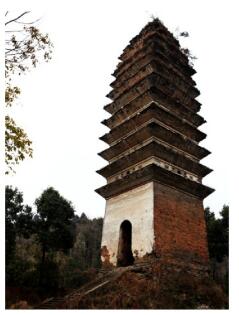
 下载:
下载:
